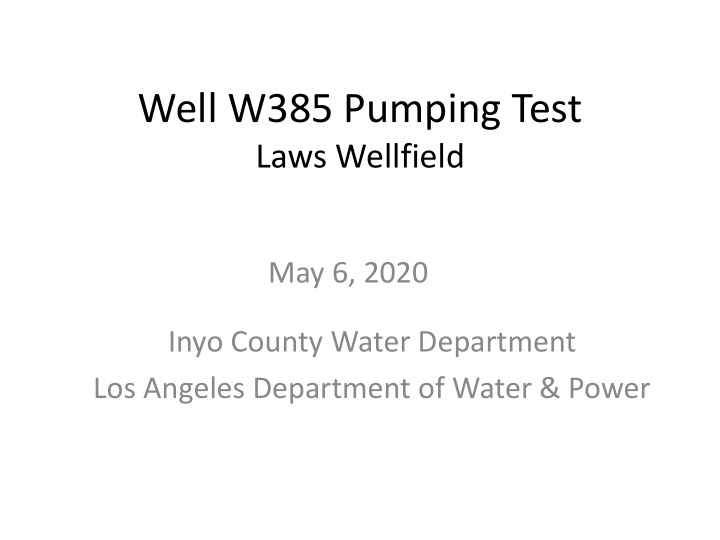



Well W385 Pumping Test Laws Wellfield May 6, 2020 Inyo County Water Department Los Angeles Department of Water & Power
Original W385 Construction Design • Pumped from both shallow 40’ and deep aquifers • Pumping impacted Five Bridges Area’s groundwater screened dependent vegetation • Conducted 1993-94 Pumping Test of combined W385 and W386 at 16.3 cfs 550’ • 10.1 cfs for W385 + 6.2 cfs for W386 Original W385 Construction Design (W386 design is similar to W385)
W385 Construction Modification • Sealed portions screened to the shallow aquifer • Pumps primarily from the deeper portion of aquifer • Reduced pumping capacity to 3.7 cfs (by 64%) 330’ screened 550’ W385 Construction Modification (W386 was modified similar to W385)
Purpose of the Pumping Test • Document the effectiveness of modifying W385 in minimizing potential pumping impacts on shallow groundwater levels • Compare groundwater level measurements with the 1993-94 pumping test to provide an indication of effects on shallow groundwater level • Recalibrate Bishop/Laws groundwater flow model to simulate the effect of potential operation
Hydrologic Monitoring Timeline • 64 days • 3.7 cfs pumping rate • 42 days • 469 AF volume pumped Recovery Phase Pumping Phase (2/18/20-3/31/20) (12/16/19-2/18/20) Jan 1 Mar 1 2020 Dec 1 2019 2020 Feb 1 2020 Apr 1 First Water Quality Sampling Second Water Quality Sampling (12/5/19) (2/13/19) • • • FS #2 T758 All wells sampled on 12/15/19 • • • FS #3D T826 And W386 • • FS #3S W385 • T755
Monitored flow through Fish Slough Maintained outflow from Pleasant Valley Reservoir at 150 cfs Stopped diverting water into the McNally Canals Stopped releasing water from Bishop Creek Canal Div. #2
Trigger Wells and Trigger Levels Well Trigger Level from Ref. Point (ft) Trigger Level AMSL (ft) T830 6.10 4148.15 T826 7.60 4140.94 Private Well 21.40 4164.60 FS #2 4.70 4180.55 FS #3S 15.30 4178.92 FS #3D 16.00 4178.84 Stop pumping if groundwater in any trigger well falls below trigger level
PUMPING PHASE RECOVERY PHASE
Water Quality Sampling • In Situ Measurements – Dissolved Oxygen Concentration, Fluid Turbidity, pH, etc. • Laboratory General Chemistry Measurements – Arsenic, Bicarbonate, Calcium, etc. • Laboratory Isotope Measurements – Oxygen-18, Deuterium, Tritium
Next Steps 1. Compare groundwater measurements with those of the 1993-94 pumping test Analyze the effects of pumping W385 (and potentially W386) on shallow groundwater levels utilizing data gathered from the pumping test 2. Estimate aquifer characteristics using data collected 3. Recalibrate the Bishop/Laws groundwater flow model and simulate alternative operations
Recommend
More recommend